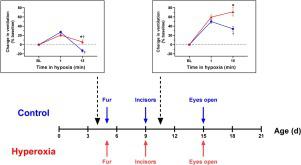Respiratory Physiology & Neurobiology ( IF 1.9 ) Pub Date : 2020-06-25 , DOI: 10.1016/j.resp.2020.103483 Michaela Pinette 1 , Ryan W Bavis 1

|
Newborn mammals exhibit a biphasic hypoxic ventilatory response (HVR) in which an initial increase in ventilation is followed by a decline back toward baseline levels. The magnitude of the secondary decline diminishes with postnatal age, but this transition occurs earlier in rat pups reared in moderate hyperoxia. This pattern is consistent with heterokairy, a form of developmental plasticity in which environmental factors alter the timing of developmental events. The present study investigated whether this plasticity is specific to the HVR or if hyperoxia instead accelerates overall development. Rat pups reared in 60% O2 (Hyperoxia) exhibited a less biphasic ventilatory response to 12% O2 than pups reared in 21% O2 (Control) at 4 days of age (P4) and transitioned to a sustained HVR by P10-11; Control rats exhibited a biphasic HVR at both ages. However, the average ages at which pups attained other key developmental milestones (i.e., fur development at P5, incisor eruption at P9, and eye opening at P15) were similar between treatment groups. Moreover, growth rates and maturation of the metabolic response to cooling were not accelerated, and may have been delayed slightly, relative to Control rats. For example, the capacity for pups to increase their metabolic rate at low ambient temperatures increased with age, but this thermogenic capacity tended to be reduced in Hyperoxia pups at both P4 and P10-11 (i.e., lower CO2 production rates below the lower critical temperature). Collectively, these data support the conclusion that hyperoxia specifically advances the age at which rat pups exhibit a sustained HVR, altering the relative timing of developmental events rather than compressing the entire period of development.
中文翻译:

慢性高氧对大鼠缺氧通气反应相对于其他特征的发育时间过程的影响。
新生哺乳动物表现出双相缺氧通气反应 (HVR),其中通气量的初始增加随后下降回基线水平。二次衰退的幅度随着出生后年龄的增长而减小,但这种转变发生在中度高氧条件下饲养的幼鼠中较早。这种模式与异环体一致,这是一种发育可塑性的形式,其中环境因素改变了发育事件的时间。本研究调查了这种可塑性是否特定于 HVR,或者高氧是否会加速整体发展。与在 21% O 2 中饲养的幼鼠相比,在 60% O 2 (Hyperoxia) 中饲养的幼鼠对 12% O 2表现出更小的双相通气反应(对照)在 4 日龄(P4)时并在 P10-11 时转变为持续的 HVR;对照大鼠在两个年龄都表现出双相 HVR。然而,幼犬达到其他关键发育里程碑(即 P5 时皮毛发育、P9 时门牙萌出和 P15 时睁眼)的平均年龄在治疗组之间相似。此外,相对于对照大鼠,对冷却的代谢反应的生长速率和成熟没有加速,并且可能略微延迟。例如,幼崽在低环境温度下增加代谢率的能力随着年龄的增长而增加,但这种产热能力在高氧幼崽中在 P4 和 P10-11(即较低的 CO 2低于临界温度下的生产率)。总的来说,这些数据支持这样一个结论,即高氧特别会提高幼鼠表现出持续 HVR 的年龄,改变发育事件的相对时间,而不是压缩整个发育时期。











































 京公网安备 11010802027423号
京公网安备 11010802027423号